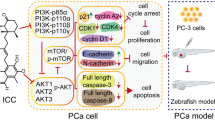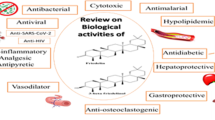Abstract
The Janus kinases (JAKs) are a family of intracellular tyrosine kinases that play an essential role in many basic biological processes, such as apoptosis and inflammation. Thus any dysfunction of the proteins in this pathway may lead to a variety of diseases, including cancer and diseases that affect the immune system, such as severe combined immune deficient (SCID). Marine biological resources have become an important source in new drug research and development due to their diversity, complexity and speciality. In this study, Marine alkaloid Neobacillamide A was isolated from the greedy and stubborn sponge symbiotic Bacillus atrophicus C89 in the South China Sea. Totally 24 novel marine alkaloid Neobacillamide A derivatives were designed and synthesized, which were evaluated for their inhibitory activity against JAK/STAT signaling pathway and their cytotoxicity to A549 cells. Compounds 13c, 13o, 14d, 14g and 14h showed potent JAK/STAT inhibition capability (concentration of 25 µmol L−1, all inhibitory potencies were above 60%), especially compound 14g exhibited superior JAK/STAT inhibition effect (89.70% inhibition). In addition, all these compounds with a concentration of 25 µmol L−1 displayed weak or no cytotoxicity to A549 cells, which means that these Neobacillamide A derivatives with JAK/STAT inhibition capability may have potential anti-inflammatory function.
Similar content being viewed by others
References
Bahekar, R., Panchal, N., Soman, S., Desai, J., Patel, D., and Argade, A., et al., 2020. Discovery of diaminopyrimidine-carboxamide derivatives as JAK3 inhibitors. Bioorganic & Medicinal Chemistry Letters, 99: 103851.
Barua, S., Chung, J. I., Kim, A. Y., Lee, S. Y., Lee, S. H., and Baik, E. J., 2017. Jak kinase 3 signaling in microgliogenesis from the spinal nestin+ progenitors in both development and response to injury. Neuroreport, 28: 929–935.
Bhide, R. S., Keon, A., Weigelt, C., Sack, J. S., Schmidt, R. J., Lin, S., et al., 2017. Discovery and structure-based design of 4,6-diaminonicotinamides as potent and selective IRAK4 inhibitors. Bioorganic & Medicinal Chemistry Letters, 27: 4908–4913.
Blunt, M. D., Koehrer, S., Dobson, R. C., Larrayoz, M., Wilmore, S., and Hayman, A., 2017. The dual Syk/JAK inhibitor cerdulatinib antagonizes B-cell receptor and microenvironmental signaling in chronic lymphocytic leukemia. Clinical Cancer Research, 23: 2313–2324.
Chen, M., Cheng, A., Chen, Y. Q., Hymel, A., Hanson, E. P., Kimmel, L., et al., 1997. The amino terminus of JAK3 is necessary and sufficient for binding to the common g chain and confers the ability to transmit interleukin 2-mediated signals. Proceedings of the National Academy of Sciences, 94: 6910–6915.
Clark, J. D., Flanagan, M. E., and Telliez, J. B., 2014. Discovery and development of Janus kinase (JAK) inhibitors for inflammatory diseases. Journal of Medicinal Chemistry, 57: 5023–5038.
Clere-Jehl, R., Mariotte, A., Meziani, F., Bahram, S., Georgel, P., and Helms, J., 2020. JAK-STAT targeting offers novel therapeutic opportunities in sepsis. Trends in Molecular Medicine, 26: 987–1002.
Coffey, G. P., Feng, J., Betz, A., Pandey, A., Birrell, M., Leeds, J. M., et al., 2019. Cerdulatinib pharmacodynamics and relationships to tumor response following oral dosing in patients with relapsed/refractory B-cell malignancies. Clinical Cancer Research, 25: 1174–1184.
Elliott, N. E., Cleveland, S. M., Grann, V., Janik, J., Waldmann, T. A., and Dave, U. P., 2011. FERM domain mutations induce gain of function in JAK3 in adult T-cell leukemia/lymphoma. Blood, 118: 3911–3921.
Flanagan, M. E., Blumenkopf, T. A., Brissette, W. H., Brown, M. F., Casavant J. M., Shang-Poa, C., et al., 2010. Discovery of CP-690,550: A potent and selective Janus kinase (JAK) inhibitor for the treatment of autoimmune diseases and organ transplant rejection. Journal of Medicinal Chemistry, 53: 8468–8484.
Fleischmann, R., 2012. Novel small-molecular therapeutics for rheumatoid arthritis. Current Opinion in Rheumatology, 24: 335–341.
Harrison, C., Kiladjian, J. J., Al-Ali, H. K., Gisslinger, H., Waltzman, R., Stalbovskaya, V., et al., 2012. JAK inhibition with ruxolitinib versus best available therapy for myelofibrosis. The New England Journal of Medicine, 366: 787–798.
Hart, S., Goh, K. C., Novotny-Diermayr, V., Tan, Y. C., Madan, B., Amalini, C., et al., 2011. Pacritinib (SB1518), a JAK2/FLT3 inhibitor for the treatment of acute myeloid leukemia. Blood Cancer Journal, 1: e44.
Ito, M., Yamazaki, S., Yamagami, K., Kuno, M., Morita, Y., Okuma, K., et al., 2017. A novel JAK inhibitor, peficitinib, demonstrates potent efficacy in a rat adjuvant-induced arthritis model. Journal of Pharmacological Sciences, 133: 25–33.
Jensen, K. V., Cseh, O., Aman, A., Weiss, S., and Luchman, H. A., 2017. The JAK2/STAT3 inhibitor pacritinib effectively inhibits patient-derived GBM brain tumor initiating cells in vitro and when used in combination with temozolomide increases survival in an orthotopic xenograft model. PLoS One, 12: e0189670.
Liu, Q., Sabnis, Y., Zhao, Z., Zhang, T., Buhrlage, S. J., Jones, L. H., et al., 2013. Developing irreversible inhibitors of the protein kinase cysteinome. Chemistry & Biology, 20: 146–159.
Lu, Z., Hong, C. C., Jark, P. C., Assumpção, A. L. F. V., Bollig, N., Kong, G., et al., 2017. JAK1/2 inhibitors AZD1480 and CYT387 inhibit canine B-cell lymphoma growth by increasing apoptosis and disrupting cell proliferation. Journal of Veterinary Medical Science, 31: 1804–1815.
Martínez, V., and Davyt, D., 2013. Total syntheses of bacillamide C and neobacillamide A; revision of their absolute configurations. Tetrahedron: Asymmetry, 24: 1572–1575.
Monaghan, K. A., Khong, T., Burns, C. J., and Spencer, A., 2011. The novel JAK inhibitor CYT387 suppresses multiple signalling pathways, prevents proliferation and induces apoptosis in phenotypically diverse myeloma cells. Leukemia, 25: 1891–1899.
O’Shea, J. J., Holland, S. M., and Staudt, L. M., 2013. JAKs and STATs in immunity, immunodeficiency, and cancer. The New England Journal of Medicine, 368: 161–170.
Changelian, P. S., Flanagan, M. E., Ball, D. J., Kent, C. R., Magnuson, K. S., and Martin, W. H., et al., 2003. Prevention of organ allograft rejection by a specific Janus kinase 3 inhibitor. Science, 302: 875–878.
Schwartz, D. M., Bonelli, M., Gadina, M., and O’Shea, J. J., 2016. Type I/II cytokines, JAKs, and new strategies for treating autoimmune disease. Nature Reviews Rheumatology, 12: 25–36.
Shinde, P., Banerjee, P., and Mandhare, A., 2019. Marine natural products as source of new drugs: A patent review. Expert Opinion on Therapeutic Patents, 29: 283–309.
Thorarensen, A., Dowty, M. E., Banker, M. E., Juba, B., Jussif, J., Lin, T., et al., 2017. Design of a Janus kinase 3 (JAK3) specific inhibitor 1-((2S,5R)-5-((7H-pyrrolo[2,3-d]pyrimidin-4-yl) amino)-2-methylpiperidin-1-yl) prop-2-en-1-one (PF-06651600) allowing for the interrogation of JAK3 signaling in humans. Journal of Medicinal Chemistry, 60: 1971–1993.
Verbsky, J. W., Bach, E. A., Fang, Y. F., Yang, L. P., Randolph, D. A., and Fields, L. E., 1996. Expression of Janus knase 3 in human endothelial and other non-lymphoid and non-myeloid cells. Journal of Biological Chemistry, 271: 13976–13980.
West, K., 2009. CP-690550, a JAK3 inhibitor as an immunosuppressant for the treatment of rheumatoid arthritis, transplant rejection, psoriasis and other immune-mediated disorders. Current Opinion in Investigational Drugs, 10: 491–504.
Yin, Y., Chen, C. J., Yu, R. N., Shu, L., Wang, Z. J., Zhang, T. T., et al., 2020. Novel 1H-pyrazolo[3,4-d] pyrimidin-6-amino derivatives as potent selective Janus kinase 3 (JAK3) inhibitors. Evaluation of their improved effect for the treatment of rheumatoid arthritis. Bioorganic Chemistry, 98: 103720.
Yu, L. L., Li, Z. Y., Peng, C. S., Li, Z. Y., and Guo, Y. W., 2009. Erratum: Neobacillamide A, a novel thiazolecontaining alkaloid from the marine bacterium Bacillus vallismortis C89, associated with South China Sea sponge Dysidea avara. Helvetica Chimica Acta, 92 (3): 607–612.
Acknowledgements
The authors are grateful for financial supports granted by the National Natural Science Foundation of China (Nos. 82073759 and 82003583), the Fund of Greater Bay Area Institute of Precision Medicine (Guangzhou) (No. IPM20 21C009), and the National Science and Technology Major Project for Significant New Drugs Development (No. 20 18ZX09735004).
Author information
Authors and Affiliations
Corresponding authors
Rights and permissions
About this article
Cite this article
Wang, J., Li, M., Zhang, X. et al. Design, Synthesis and Bioactivity Study of Marine Alkaloid Neobacillamide—A Derivatives. J. Ocean Univ. China 22, 790–800 (2023). https://doi.org/10.1007/s11802-023-5381-3
Received:
Revised:
Accepted:
Published:
Issue Date:
DOI: https://doi.org/10.1007/s11802-023-5381-3




